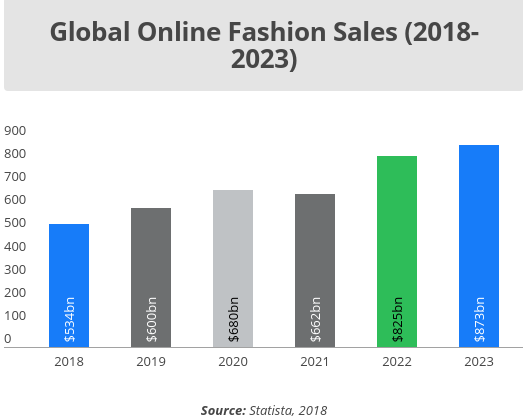As the eCommerce fashion industry is buckling up to enter the post-pandemic era, let’s take a look at the changes that embraced the fashion industry around the world.

eCommerce fashion industry – Statistics
According to a recent report by JECD, fashion is a highly sophisticated, $2.5 trillion global industry. The fashion eCommerce market is the collection of revenue from the business of the income generated by the business using multiple online platforms. This market has seen tremendous growth since 2018.
In 2018, the industry generated worldwide revenue of $481 billion. This became $545 billion in 2019. It is projected to rise further to $713 billion by 2022.
Here are some of the interesting statistics insights on eCommerce Fashion Industry for 2021:
- The post-pandemic fashion e-commerce market is still expected to grow at a CAGR of 11.5 percent for the next three years.
- eCommerce transactions are projected to spike up to 36% of total fashion retail by 2022 (Source: Forrester).
- The U.S. apparel market size is projected to $390bn U.S. for 2025 (Source: Statista)
- As the work from home strategies are still in place, Euromonitor observes that activewear sales will grow by 6.1% next year.
- According to Statista, the global online fashion market was worth $533 billion in 2018 and is predicted to grow to $872bn by 2023.

- Mobile accounts for 65.4% of traffic to online fashion retailers and 57.1% of sales, much higher than the overall retail average (Source: SaleCycle data from 500 Global brands)

- With a projected market volume of US$61,735m in 2021, in the bags and accessory industry, the most revenue will be generated in China.
eCommerce fashion industry – Trends & strategies
Buy now, pay later
‘Buy now pay later’ is a trending form of purchasing that the eCommerce fashion industry is after. It is embedded throughout the online fashion industry irrespective of its size. This clearly is the result of changing the customer mindset and can be attributed to the factors:
- Affordability: it lets the customer pay for it over a period of time
- Predictability: it helps the customer plan ahead the amount that you’re are going to pay
- Transparency: It helps the customer balance the budget
Thus, reinventing your payment strategies will drive your future growth to cope up with the shifts in customer mindset.
AR & VR fitting rooms
Shopping from physical stores allows the customers to try out the product, giving a better idea about the product. Today, fitting rooms facilitated by Augmented Reality and Virtual Reality are becoming the ongoing trend in the fashion industry by letting the customers try out the products such as apparel, eyewear, and other accessories virtually. This way, clubbing the features of VR in the ever-evolving fashion sector, engaging the customers in an interactive and personalized way becomes easier.
Also, Adopting this breakthrough technology solves the challenge of product fitting thereby boosting the revenue.
Genderless fashion
Unisex garments are seen as a symbol of inclusion and diversity. Genderless collections in fashion are leading the way these days, says the insights from Stylus Trends Intelligence Summit. As the consumers are becoming more and more demanding when it comes to sustainability and eco-friendly fabrics, the industry leaders perceive this as the perfect moment to experiment with sustainable, unisex designs and innovative dying technologies.
As the retailers are reassessing their strategies and designers are reinventing their ideas, the gender-neutral verticle is gaining strength as a widely followed trend. However, the challenge to be addressed is that the words ‘unisex’ and ‘gender-neutral’ should be widely publicized in the industry and the focus on a single-gender should be curbed.
Mobile-friendly and Smartphone technology
Yet another trend that is seen when we move to the post-pandemic era is the use of Mobile-friendly and Smartphone technology. Retailers in the eCommerce fashion industry are migrating to mCommerce on a largescale. Smartphone technology offers a top-notch interface for the customers specifically on smaller screens. The contemporary and upscaled layout in mobiles and tablets persuades the customers to download the app. This in turn decreases the bounce rates.
Omnichannel commerce and D2C
Omnichannel retail is a multichannel approach that focuses on offering a seamless customer experience whether the customer is shopping online from a mobile device, a laptop, or in a brick-and-mortar store. Through omnichannel fashion, retailers are trying to drive customers by both an offline and online presence thereby unifying brand experiences.
Some of the trendsetters in fashion industry are even trying omnichannel strategy of “reserve online, try on in-store” which is likely to catch up the pace in the recent future.
Direct-to-customer (D2C)
The eCommerce retailers in the fashion industry are adopting yet another trend with a segmented approach to supply in order to fulfill different customer needs. They are making certain products mostly the exclusive, limited-edition items online only in a direct-to-consumer strategy,. Recently, Nike attributed its growth rate to its direct-to-consumer (D2C) sales and termed them as a key driver of its sales for the immediate future.
What’s next in the eCommerce fashion industry?
The online fashion industry as we know it is ever-booming in a breakneck speed, and has been agile since its inception. The emergence of concepts such as reCommerce and sustainability are a few of the change indicators. ReCommerce, according to Yieldify, is the process of renting, reselling, or thrifting previously owned apparel through online or offline stores. The search for economical, sustainable ways of owning a product is in the air as the pandemic hit the world. As more conversations continue, reCommerce and sustainability concepts will prosper in the foreseeable future.
With the emergence of better AI and personalization opportunities, it is nearly impossible to predict the growth turn that the eCommerce fashion sector is going to take in the future.
Bottom line
Having said all these, the golden rule is to aim to provide the customers with the best that you have and the customer reciprocates. Everything other than this customer response is unpredictable. The safest methods to be prepared for the eCommerce fashion industry in 2021 is to:
- Ensure better customer experience.
- Adopt personalization
- Work on your social media marketing strategies
- Explore AI, AR and VR
- Be updated with Google algorithm updates
Already a WooCommerce store owner? Build a Mobile App to Win More Customers
Appmaker specialises in Quality and Performance guaranteed, E-Commerce Android/iOS Apps for E-Commerce Businesses. Get in touch










No Comments
Leave a comment Cancel